Jon Peddie is “genuinely delighted” by the possibilities this wearable PC offers.
By Jon Peddie
When HP announced the Omen X VR backpack computer in May, I said, “Wow! — I bet they’ll sell hundreds of them.” I may have to eat those words, and it would delight me if I do.

The problem with a thing like the Omen is, it’s one of those things you have to experience to get. That’s the good news and the bad. It’s good because when you do experience it, you’re genuinely delighted. I can honestly say it was one of the best VR experiences I have had—and there were plenty of folks watching me, so you know I’m not faking this. The bad news is if the concept can’t explained be well enough without trying it (let’s see how well I do), then the sales will be limited to how many people can try one.
The Omen X is creating a new segment in the PC market, the wearable PC. The idea has been explored since the late 1990s as part of the early AR experiments, and the University of Australia developed a wearable system in 1999 to play AR Doom.
The Omen X is not officially a shipping product yet; you can’t go out and buy one. They are being offered to qualified developers. However, the initial specifications read well. There is an Intel i7 in it, it weighs less than 10 pounds, and its dimensions are 12.49 × 9.14 × 2.26 inches. The unit has two belt-mounted battery packs that keep it powered for one to two hours, and its internal battery will allow you to hot-swap the battery packs while the system is running. If you have two extra units charging while you’re playing, the playtime may be infinite. When asked about the GPU, HP could only comment that it was an “undisclosed GPU,” but the Omen X passes the Steam performance tests and worked as smooth as a desktop system when I tried it. The unit I tried was using the HTC Vive headset. HP also used it with the Oculus Rift when they helped with the making of the film Giant.
The system isn’t just for VR; detach the straps and this wireless VR system becomes a damn fine portable, or desktop, machine—but it needs a display. It has two USB 3.0, two USB Type-C, one HDMI-out, one audio combo jack, and DC-out for a headset. If you have a head-mounted display connected like the HTC Vive, you can use the built-in wireless display to connect an external monitor.

What do we think?
I was extremely skeptical about the Omen, thinking it was going to be an embarrassment for HP. And that skepticism melted away within minutes after using it. It felt totally natural; in fact, I wasn’t even aware of it. If you wore it for an extended period of time, you’d probably start to feel it, just as you would feel your arms when holding them out in space shooting zombies or creating 3D art.
I think it has arcade potential, and possibly will be attractive to people who want to play or paint in a big world. Imagine playing Stalker or Skyrim in it. It could be fun for a VR party with several of your friends.





